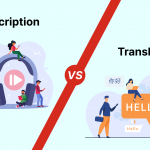What is Films and TV Transcription?
Films and TV transcription is used in TV broadcasting, programs, live shows, etc. Put simply, audio-visual information is converted into an accurate text file.
These text documents are then re-read, analyzed, quoted, or even published for public consumption. For example, if the new budget for a country is broadcast, transcripts are published for public circulation.
Sometimes, the entire media file does not need transcription, but only a small part does- for example, the recipes that come on the screen as text on a cooking show.
These transcripts also assist foreign language lessons where students can highlight crucial points in their notes, and read everything many times over, which is difficult if only the audio file of the lesson is available.
Why is Films and TV Transcription important?
Films and TV Transcription helps content created for television and film projects reach wider audiences, boosts revenues, and increases engagement among content consumers.
Such services are also needed for making closed captions of TV shows and films. Transcripts of interviews broadcast on television are made available for the mainstream media and social media platforms for posterity.
Use cases:
- Raw Footage:
Raw footage transcription is a great method to search for key phrases and determining speakers. Transcribing raw footage is a great way to save time during post-production.
However, one of the downsides of transcribing raw footage is that it takes a lot more time than it would take for transcribing the final media file.
- Post production:
After the completion of your project, it needs to be transcribed for distribution or archival purposes. You may need to produce a word-accurate dialog and speaker ID transcript (for the dialog list). You may need to include breaks, scene breakdowns, descriptions, continuity etc.
Two of the most challenging post production transcripts to produce are the combined continuity and spotting list. Each shot needs to be numbered in these lists and produce an accurate time reference. In addition, continuity must be described in a concise manner with word-accurate dialog transcripts, and main titles with timing.
- Subtitling:
Out of the total 7.8 billion people in the world, 1.35 billion are English speakers. However, only 360 million people speak English as their first language. The most common first language is Chinese, followed by Spanish and then, English. (Source: Babbel)
Transcribed television or film content makes translation into other languages possible. More languages = more eyeballs.
- Closed Captioning:
People with hearing impairments, or those watching any content in noisy environments or even quiet places, or who can read English but are not familiar with the accents of native English speakers, and those who appreciate the ability to entirely focus on what’s being said prefer closed captioning.
Closed captioning is a great way to popularize content.
Bespoke Films and TV Transcription:
The globally dominant social media, has enabled people to share information about their favourite television programs and films. Members of mainstream media also use it to share news and gauge interest in specific productions.
Importance of using a professional service for projects:
With huge budgets, both Films and TV are exacting disciplines and there is hardly any room for error. Amateur work is therefore best avoided as even minor errors are glaring on screen.
Highly accurate captions and subtitles, produced by contextually cognizant transcribers add value to each file and TV production. Also, transcribed text of shows, interviews, or episodes that have been broadcast already may need to be referenced at any time. A professional transcription service fits the bill to perfection.









Share your thoughts